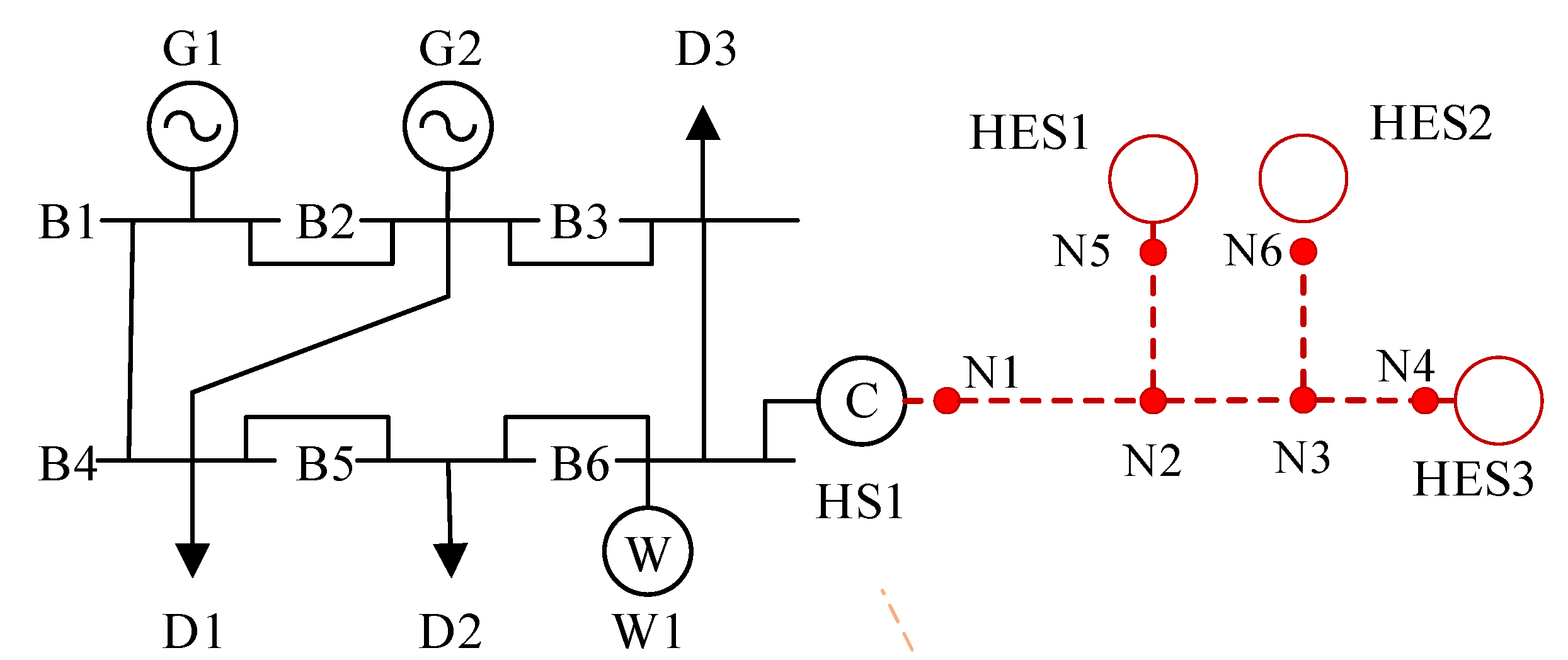A Robust Interval Optimization Method for Combined Heat and Power Dispatch
Abstract
:1. Introduction
2. Deterministic Model of CHPD
2.1. Objective Function
2.2. DHS Constraints
2.2.1. Heat Station
2.2.2. District Heating Network
2.2.3. Heat Loads
2.3. EPS Constraints
3. Robust Model of CHPD and the Solution Method
3.1. Formulation of Robust CHPD
- The worst-case scenario for the upward-spinning reserve constraint is
- 2.
- The worst-case scenario for the downward spinning reserve constraint is
- 3.
- The worst-case scenario for the positive transmission interface flow constraint is
- 4.
- The worst-case scenario for the negative transmission interface flow constraint is
3.2. Model Simplification
4. Case Study
5. Conclusions
Author Contributions
Funding
Data Availability Statement
Conflicts of Interest
References
- Li, Z.; Wu, W.; Shahidehpour, M.; Wang, J.; Zhang, B. Combined Heat and Power Dispatch Considering Pipeline Energy Storage of District Heating Network. IEEE Trans. Sustain. Energy 2016, 7, 12–22. [Google Scholar] [CrossRef]
- Chen, X.; McElroy, M.B.; Kang, C. Integrated Energy Systems for Higher Wind Penetration in China: Formulation, Implementation and Impacts. IEEE Trans. Power Syst. 2017, 33, 1309–1319. [Google Scholar] [CrossRef]
- Dai, Y.; Chen, L.; Min, Y.; Mancarella, P.; Chen, Q.; Hao, J.; Hu, K.; Xu, F. Integrated Dispatch Model for Combined Heat and Power Plant With Phase-Change Thermal Energy Storage Considering Heat Transfer Process. IEEE Trans. Sustain. Energy 2018, 9, 1234–1243. [Google Scholar] [CrossRef]
- Dai, Y.; Chen, L.; Min, Y.; Mancarella, P.; Chen, Q.; Hao, J.; Hu, K.; Xu, F. A General Model for Thermal Energy Storage in Combined Heat and Power Dispatch Considering Heat Transfer Constraints. IEEE Trans. Sustain. Energy 2018, 9, 1518–1528. [Google Scholar] [CrossRef]
- Wu, C.; Gu, W.; Jiang, P.; Li, Z.; Cai, H.; Li, B. Combined Economic Dispatch Considering the Time-Delay of District Heating Network and Multi-Regional Indoor Temperature Control. IEEE Trans. Sustain. Energy 2018, 9, 118–127. [Google Scholar] [CrossRef]
- Zheng, J.; Zhou, Z.; Zhao, J.; Wang, J. Effects of the Operation Regulation Modes of District Heating System on an Integrated Heat and Power Dispatch System for Wind Power Integration. Appl. Energy 2018, 230, 1126–1139. [Google Scholar] [CrossRef]
- Huang, X.; Xu, Z.; Sun, Y.; Xue, Y.; Wang, Z.; Liu, Z.; Li, Z.; Ni, W. Heat and Power Load Dispatching Considering Energy Storage of District Heating System and Electric Boilers. J. Mod. Power Syst. Clean Energy 2018, 6, 992–1003. [Google Scholar] [CrossRef]
- Wang, K.; Xue, Y.; Guo, Q.; Shahidehpour, M.; Zhou, Q.; Wang, B.; Sun, H. A Coordinated Reconfiguration Strategy for Multi-Stage Resilience Enhancement in Integrated Power Distribution and Heating Networks. IEEE Trans. Smart Grid 2023, 14, 2709–2722. [Google Scholar] [CrossRef]
- Du, Y.; Xue, Y.; Lu, L.; Yu, C.; Zhang, J. A Bi-Level Co-Expansion Planning of Integrated Electric and Heating System Considering Demand Response. Front. Energy Res. 2022, 10, 999948. [Google Scholar] [CrossRef]
- Li, Y.; Zou, Y.; Tan, Y.; Cao, Y.; Liu, X.; Shahidehpour, M.; Tian, S.; Bu, F. Optimal Stochastic Operation of Integrated Low-Carbon Electric Power, Natural Gas, and Heat Delivery System. IEEE Trans. Sustain. Energy 2018, 9, 273–283. [Google Scholar] [CrossRef]
- Majidi, M.; Mohammadi-Ivatloo, B.; Anvari-Moghaddam, A. Optimal Robust Operation of Combined Heat and Power Systems with Demand Response Programs. Appl. Therm. Eng. 2019, 149, 1359–1369. [Google Scholar] [CrossRef]
- Nazari-Heris, M.; Mohammadi-Ivatloo, B.; Gharehpetian, G.B.; Shahidehpour, M. Robust Short-Term Scheduling of Integrated Heat and Power Microgrids. IEEE Syst. J. 2019, 13, 3295–3303. [Google Scholar] [CrossRef]
- Shui, Y.; Gao, H.; Wang, L.; Wei, Z.; Liu, J. A Data-Driven Distributionally Robust Coordinated Dispatch Model for Integrated Power and Heating Systems Considering Wind Power Uncertainties. Int. J. Electr. Power Energy Syst. 2019, 104, 255–258. [Google Scholar] [CrossRef]
- Du, Y.; Xue, Y.; Wu, W.; Shahidehpour, M.; Shen, X.; Wang, B.; Sun, H. Coordinated Planning of Integrated Electric and Heating System Considering the Optimal Reconfiguration of District Heating Network. IEEE Trans. Power Syst. 2023. early access. [Google Scholar] [CrossRef]
- Xue, Y.; Li, Z.; Lin, C.; Guo, Q.; Sun, H. Coordinated Dispatch of Integrated Electric and District Heating Systems Using Heterogeneous Decomposition. IEEE Trans. Sustain. Energy 2020, 11, 1495–1507. [Google Scholar] [CrossRef]
- Test Data for R-CHPD. Available online: https://docs.google.com/spreadsheets/d/1TNrEsWwrCDvDcEuHb7VnUQcul6cFcCoN/edit?usp=sharing&ouid=115924522171410221124&rtpof=true&sd=true (accessed on 26 July 2023).



| Title 1 | IHPD | CHPD | R-CHPD |
|---|---|---|---|
| USD 79,603 | USD 76,548 | USD 77,362 | |
| USD 28,329 | USD 26,421 | USD 26,958 | |
| USD 1506 | USD 501 | USD 1703 | |
| Total cost | USD 109,438 | USD 103,470 | USD 106,023 |
Disclaimer/Publisher’s Note: The statements, opinions and data contained in all publications are solely those of the individual author(s) and contributor(s) and not of MDPI and/or the editor(s). MDPI and/or the editor(s) disclaim responsibility for any injury to people or property resulting from any ideas, methods, instructions or products referred to in the content. |
© 2023 by the authors. Licensee MDPI, Basel, Switzerland. This article is an open access article distributed under the terms and conditions of the Creative Commons Attribution (CC BY) license (https://creativecommons.org/licenses/by/4.0/).
Share and Cite
Wang, J.; Zhang, J.; Pan, Z.; Ge, H.; Chang, X.; Wang, B.; Li, S.; Zhao, H. A Robust Interval Optimization Method for Combined Heat and Power Dispatch. Electronics 2023, 12, 3706. https://doi.org/10.3390/electronics12173706
Wang J, Zhang J, Pan Z, Ge H, Chang X, Wang B, Li S, Zhao H. A Robust Interval Optimization Method for Combined Heat and Power Dispatch. Electronics. 2023; 12(17):3706. https://doi.org/10.3390/electronics12173706
Chicago/Turabian StyleWang, Jinhao, Junliu Zhang, Zhaoguang Pan, Huaichang Ge, Xiao Chang, Bin Wang, Shengwen Li, and Haotian Zhao. 2023. "A Robust Interval Optimization Method for Combined Heat and Power Dispatch" Electronics 12, no. 17: 3706. https://doi.org/10.3390/electronics12173706
APA StyleWang, J., Zhang, J., Pan, Z., Ge, H., Chang, X., Wang, B., Li, S., & Zhao, H. (2023). A Robust Interval Optimization Method for Combined Heat and Power Dispatch. Electronics, 12(17), 3706. https://doi.org/10.3390/electronics12173706





